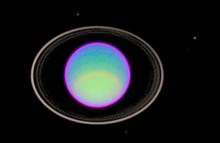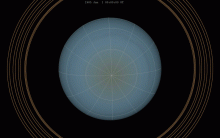Listen to today's episode of StarDate on the web the same day it airs in high-quality streaming audio without any extra ads or announcements. Choose a $8 one-month pass, or listen every day for a year for just $30.
You are here
Uranus at Opposition II
The planet Uranus is windy. Winds have been clocked at up to 560 miles per hour. That’s three times faster than a category five hurricane here on Earth.
Uranus is one of the solar system’s giants — four times the diameter of Earth. Its atmosphere consists mainly of hydrogen and helium, the lightest chemical elements. But it’s topped by clouds and hazes made of water, ammonia, and methane. The methane absorbs red light, so the planet looks blue-green.
Only one spacecraft has ever flown past the planet, and that was 34 years ago. But better telescopes and instruments on Earth have allowed scientists to look into its atmosphere. They’ve plotted jet streams in the atmosphere’s upper and middle layers.
The calmest of the jet streams is at the equator. It blows at roughly 225 miles per hour. Winds get faster as you move away from the equator. They peak at about 60 degrees north and south of it. Wind speeds then drop to near zero at the poles. Scientists continue to ponder the reasons for high-speed winds on this giant planet.
Uranus is putting on its best showing of the year. The giant planet rises around sunset and is in view all night. Under especially clear, dark skies, those with good eyesight might just make it out, shining like a faint star. Most of us, though, will need binoculars to spot it — a tiny dot shining among the countless stars of the Milky Way.
Tomorrow: Day One of 20 years in space.
Script by Damond Benningfield





